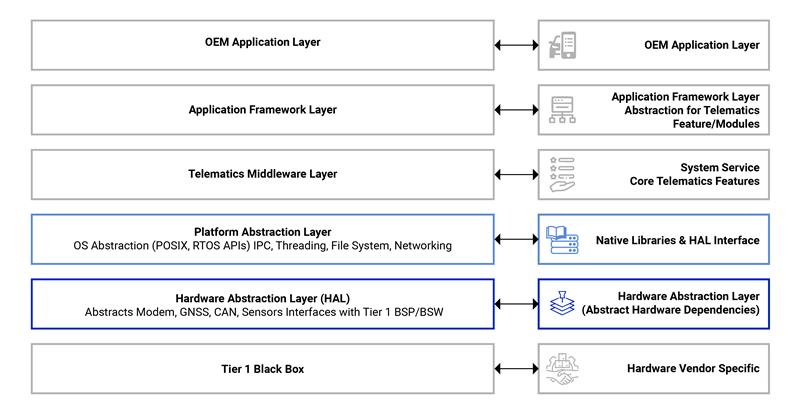Every time hardware changes, does your software team have to start from scratch? Without a Platform Abstraction Layer (PAL), this recurring engineering overhead slows OEMs and Tier-1s, inflates costs, and delays launches.
When evaluating embedded solutions, R&D, Procurement, and Leadership teams often zero in on the same critical questions:
- Can our automotive application software remain portable if we switch from one SoC vendor to another?
- Can we reduce engineering rework and validation cycles when migrating between hardware platforms?
- Is there a way to reuse existing software modules across vehicle lines without heavy re-coding?
- How can compliance with ISO 26262 and be maintained even when hardware changes?
The answers to these questions distinguish between short-term fixes and long-term, scalable solutions.
In this blog, we’ll explore:
- How the Platform Abstraction Layer (PAL) works
- Where it fits into automotive software architecture
- How it helped us craft a software development kit that gives our customers a decisive edge when developing telematics applications.
What is Platform Abstraction Layer (PAL)?
A Platform Abstraction Layer (PAL) hides the differences between the underlying hardware and its operating systems to ease the complexity in non-safety critical application development.
It provides a uniform API so developers can write standardized, portable code without worrying about whether the application will run on bare metal MCUs, RTOS-based ECUs, or Linux/QNX SoCs.
It uses the services provided by OS Abstraction Layer (OSAL) + Hardware Abstraction Layer (HAL) drivers + vendor libraries and exposes one unified API for the application.
So, PAL = HAL + OSAL
Hardware Abstraction Layer (HAL): By providing drivers & APIs for hardware peripherals such as CAN, UART & GNSS, HAL isolates developers from the hidden complexities in developing code for these hardware peripherals.
Where Does Platform Abstraction Layer Fit in the Automotive Stack?
In terms of automotive software architecture, the platform abstraction layer lies between the middleware/application layer and the OS Layer.

This ensures that middleware and applications of an automotive application software remain independent of the underlying OS and hardware.
Who Needs a PAL?
OEMs & Tier-1s work with 3 types of ECUs for non-safety critical applications; we’ve categorized them based on the complexity of operations the ECU can handle:
- Low Complexity ECU – Runs on either Baremetal or No OS, these ECUs handle mechanical functions, such as Power Windows, Wiper Control, Track & Trace. Used in two-wheeler applications.
- Medium Complexity ECU – RTOS-based platforms to handle multitasking and real-time operations. Used in high-end two-wheelers and mid-range four-wheelers. A Telematics Control Unit is an example of this kind of ECU.
- High-Complexity ECU – Linux/QNX/Android-based platforms that handle complex tasks such as multimedia & connectivity. These ECUs are used in Digital Clusters, Infotainment systems, etc. Used in high-end four-wheelers. A Telematics Gateway Unit is an example of this kind of ECU.
Rewriting the code for the same application on different platforms is what a coder’s nightmares are made of.
This, in turn, will negatively affect an OEM by extending development cycles, increasing operational costs, hardware lock-in, and longer validation cycles, and ultimately extending time-to-market.
Integrating a solution with a pre-installed platform abstraction layer helps tackle these challenges.
Functions of Platform Abstraction Layer in the Automotive Architecture
What responsibilities can a platform abstraction layer handle?
- Abstracting the operating system & hardware (platform) by providing a common API; by doing so, it shields your developers from writing platform-specific code.
- Performs thread & task management by providing standardized functions to create, run, and synchronize multiple tasks.
- Provides mechanisms (messaging queues, shared memory, semaphores) to ensure smooth inter-process communication (IPC).
- Standardizes file system operations like reading, writing, and managing logs or configuration files, allowing applications to handle data consistently across Linux, RTOS, or lightweight embedded systems.
- Unifies networking functions by exposing a common interface for sockets, TCP/IP, or higher-level protocols, enabling connected car features like and OTA to work across platforms.
- Supports middleware portability by ensuring that higher-level services (application layer) can be reused across ECU variants without rewriting code.
Our Experience with Platform Abstraction Layer
Embitel’s IoT and Mobility team developed a telematics software development kit- Telematics SDK to ease the burden on automotive R&D teams.
The solution provided customers with reusable components & APIs for the middleware and application layer of telematics systems.
By integrating abstraction layers (PAL & HAL) into the solution, we enabled hardware-independent development of telematics systems.
OEMs & Tier-1s will only have to develop the end-user application layer of the telematics system.
Automotive OEMs and fleets can now develop & integrate complete solutions for low, medium, and for two, three and four wheelers, under one roof.

